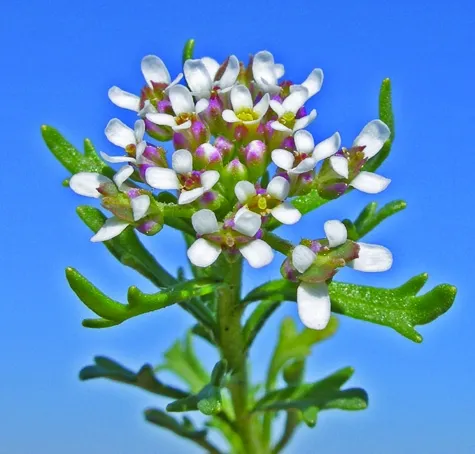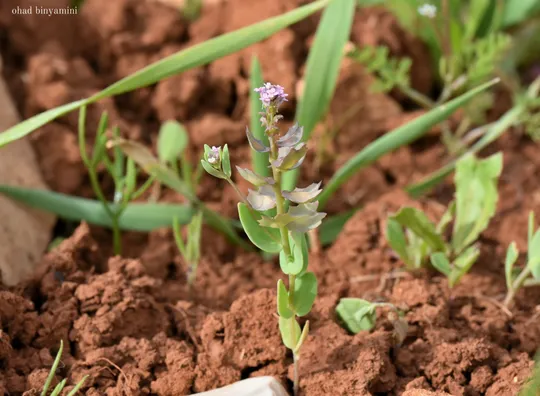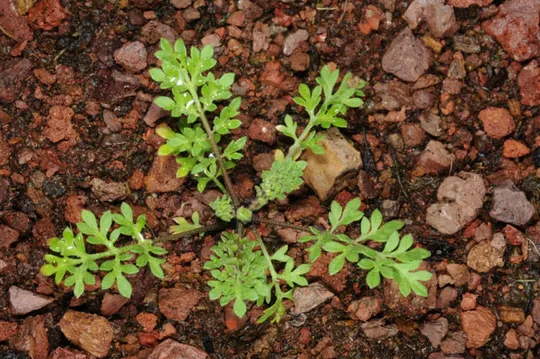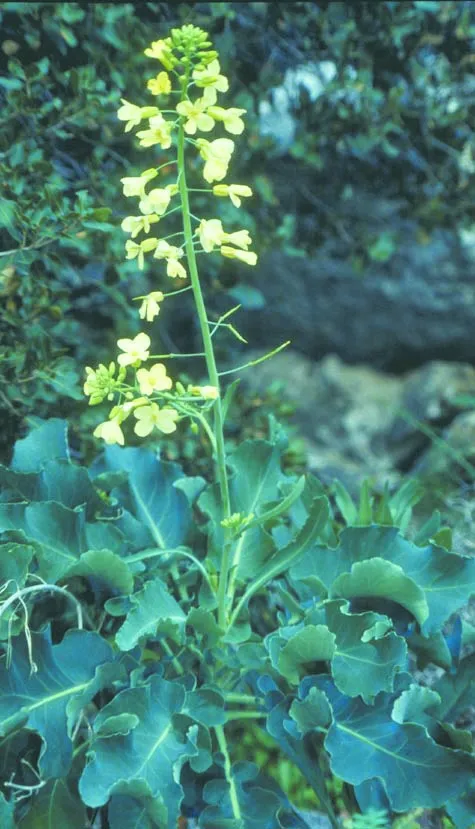Bird's-eye Cress, Perfoliate Mitre-cress
Myagrum perfoliatum

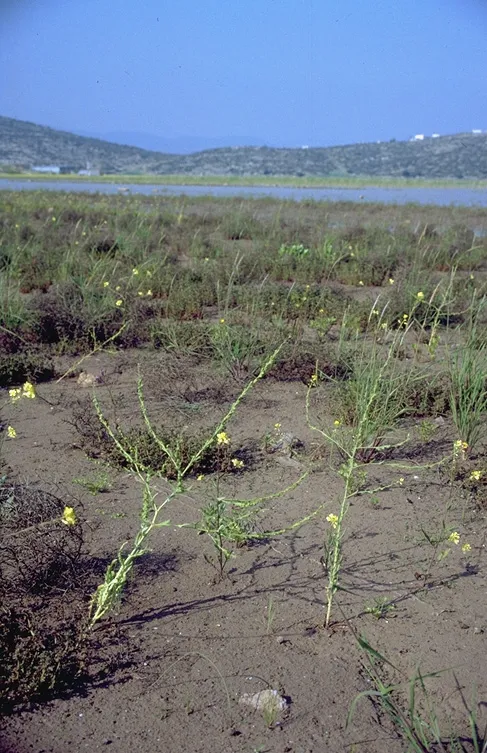
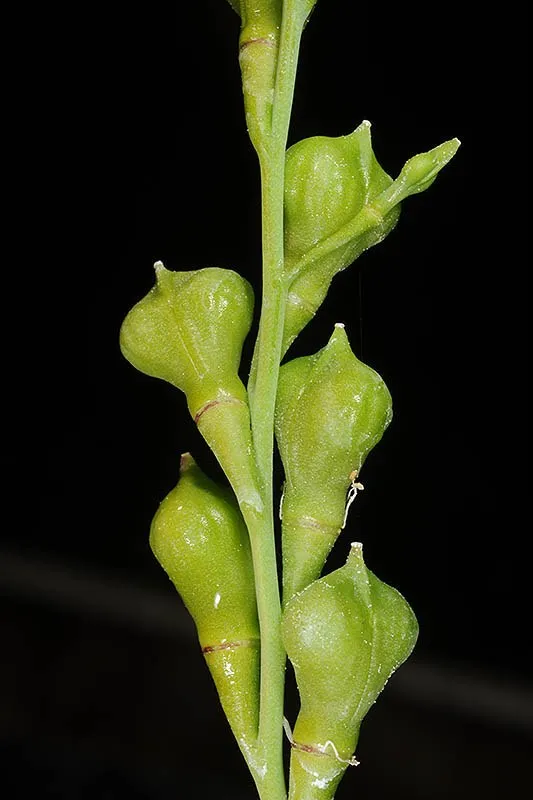
Myagrum perfoliatum is currently found
only in the Lower Galilee, and is documented from 24 sites in Israel, but there
is concern that it remains in only about 20 sites. In the Lower Galilee, it was
first discovered during the rare plant survey in 1992 as a new species for this
region, in the Sakhnin Valley and between Wadi Tsalmon and Mrar. Only a few
individual plants were found at these sites. In 1993, large populations
estimated at hundreds of thousands of plants and more were found throughout the
Bet Netofa valley, in 21 adjacent sites. Recently it was also found in Maǧdal-
Krum. Tuvia Kushnir collected M. perfoliatum in 1941 at Yagur and between Yagur
and Nesher (probably in the Acre Valley, although there are no coordinates), but
it has not been found there again.
Heavy valley soil
that are flooded in winter every few years following heavy rains.
Myagrum
perfoliatum
is a monotypic genus (containing one species) with no closely related taxons.
All the relatively closely related genera are perennial herbs whereas Myagrum is an annual. On the other hand M.
perfoliatum is related to genera with few species,
monotypic or bitypic that grow in our region – Euclidium
syriacum, Boreava aptera and Ochthodium aegyptiacum, annual species whose fruit is a 1-2 seeded silicula. The
accepted opinion that M. perfoliatum is a western Mediterranean species
turned out to be mistaken: it apparently belongs to a group of Mediterranean
genera whose center is in the Middle East and the Caucasus, adapted to
subsisting as noxious weeds in heavy soils, roadsides and shepherd habitations.
In all these species, the classic Brassicaceae siliqua was drastically
reduced to a one-seeded indehiscent spherical structure. M. perfoliatum
has an intermediate position phylogenetically in this group: it has a silicula
that is very difficult to open and contains 1-2 seeds. Most of the closely
related genera to Myagrum have a single seed in an indehiscent spherical
fruit, whereas in M. perfoliatum the silicula is dorsally flattened, but
the prominent beak is laterally flattened. This is a feature unique to this
taxon, which consequently received the status of an independent genus.
·
Myagrum
perfoliatum grows today in only one region, the Lower Galilee, from
which it was not known until the surveys of the early 1990s, while in the
region where it was found in the past – the Acre Valley – it is extinct. Due to
the late discovery of the sites in the Bet Netofa Valley it is difficult to
reach any conclusions at this stage regarding the trends of change in the
number of sites over the years and there is insufficient data on the rate of
its extinction, if indeed it occurs
·
There are
substantial inter-annual fluctuations in the in the population size of M. perfoliatum.
It is be possible that the species maintains large seed banks in the soil for
rainy years, when thousands of plants germinate and become established, while in
normal or dry years its germination rate is low.
·
The proximity of
the M. perfoliatum sites exposes the populations to a
common threat factor, such as a radical change in the water regime in the Bet
Netofa Valley, which could affect all the sites in the area, which would put
all the populations in danger of local extinction.
·
M. perfoliatum
is not protected in any nature reserve in Israel.
·
M. perfoliatum is not globally
endangered and there is evidence of the expansion as
naturalized plants in different parts of the world.
Due to its presence in a number of adjacent sites in the
Bet Netofa Valley, land should be allocated for a nature reserve in the valley,
in which a water regime of winter flooding and summer drying will be maintained.
Annual surveys should be conducted to obtain population size estimates and its
annual fluctuations, to enable informed decisions regarding its management.
Myagrum
perfoliatum
is found in southern Europe (from France and Spain up to Greece, Hungary and
Romania and on to the Crimean Peninsula) and in Turkey, Syria, Lebanon and
Israel, northeast Iraq, the Caucasus and western Iran. The population in Israel
is disjunct from other distribution areas. It has been reported as a
naturalized, and possibly invasive, species in various parts of the world
(United States, Korea, India and Australia)
Myagrum is an annual herbaceous,
monotypic genus that grows on a small number of adjacent sites on heavy valley
soil flooded in winter in the Bet Netofa Valley. The threats to the population
are a result of the great proximity of its sites and from possible changes in
the water regime of the Bet Netofa Valley. Its conservation significance in
Israel is also supported by the fact that M. perfoliatum
is the only species in its genus, despite the fact that it is apparently not
globally endangered.
Current Occupancy Map
| 1000 squre meter pixel | 5000 squre meter pixel | 10000 squre meter pixel | |
|---|---|---|---|
| number of observations | 0 | 0 | 0 |
| in total pixels | 0 | 0 | 0 |
| Family | Brassicaceae |
| Classification | On the endangered species list |
| Ecosystem | Mediterranean |
| Chorotype | Mediterranean - Western Irano – Turanian (Euro – Siberian) |
| Conservation Site | Bet Netofa Valley |
| Rarity |
1
2
6
|
|---|---|
| Vulnerability |
0
3
4
|
| Attractiveness |
0
0
4
|
| Endemism |
0
0
4
|
| Red number |
1
3.2
10
|
| Peripherality | N |
| IUCN category | DD EW EX LC CR EN VU NT |
| Threat Definition according to the red book | Vulnerable |
 Based on:
Based on:
